1972年国际海上避碰规则中英
- 格式:doc
- 大小:76.50 KB
- 文档页数:15
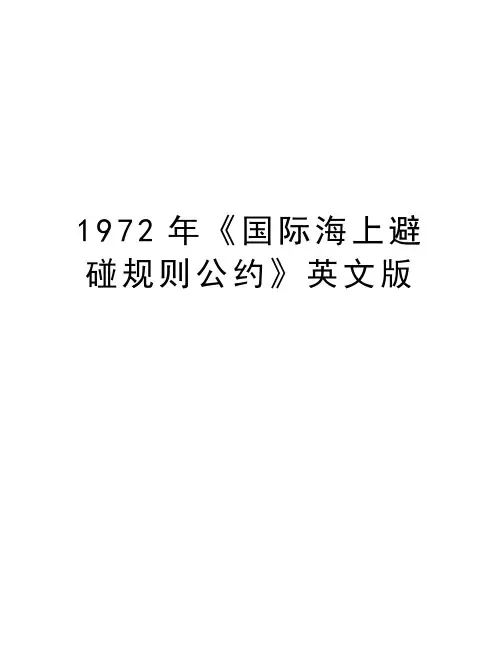
1972年《国际海上避碰规则公约》英文版
仅供学习与交流,如有侵权请联系网站删除谢谢2
仅供学习与交流,如有侵权请联系网站删除谢谢3
仅供学习与交流,如有侵权请联系网站删除谢谢4
仅供学习与交流,如有侵权请联系网站删除谢谢5
仅供学习与交流,如有侵权请联系网站删除谢谢6
仅供学习与交流,如有侵权请联系网站删除谢谢7
仅供学习与交流,如有侵权请联系网站删除谢谢8
仅供学习与交流,如有侵权请联系网站删除谢谢
仅供学习与交流,如有侵权请联系网站删除谢谢10
11
12
13
14
15
16
17
18
19
20
21
22
23
24
25
26
27
28
29
30
31
32。

1972 年国际海上避碰规则INTERNATIONAL REGULATIONS FORPREVENTING COLLISIONS AT SEA,1972(第1- 19条)第一章总则Part A –General第一条Rule 1适用范围Application1 本规则条款适用于公海和连接于公海而可供海船航行的一切水域中的一切船舶。
(a)These Rules shall apply to all vessels upon the high seas and in all watersconnected therewith navigable by seagoing vessels.2本规则条款不妨碍有关主管机关为连接于公海而可供海船航行的任何港外锚地、江河、湖泊或内陆水道所制订的特殊规定的实施。
这种特殊规定,应尽可能符合本规则条款。
(b)Nothing in these Rules shall interfere in the operation of special rules madeby an appropriate authority for roadsteads, harbors, rivers, lakes or inland waterwaysconnected with the high seas and navigable by seagoing vessels. Suchspecial rulesshall conform as closely as possible to these Rules.3.本规则条款不妨碍各国政府为军舰及护航下的船舶所制定的关于额外的队形灯、信号灯、号型或笛号,或者为结队从事捕鱼的渔船所制定的关于额外的队形灯、信号灯或号型的任何特殊规定的实施。
这些额外的队形灯、信号灯、号型或笛号,应尽可能不致被误认为本规则其他条文所规定的任何号灯、号型或信号。
1 / 22(c) Nothing in these Rules shall interfere with the operation of any special rulesmade by the Government of any State with respect to additional station or signallights or shapes or whistle signals for ships of war and vessels proceeding underconvoy, or with respect to additional station or signal lights for fishing vessels fishingas a fleet. These additional station or signal lights or whistle signals shall, so far aspossible, be such that they cannot be mistaken for any light, shape, or signalauthorized elsewhere under these Rules.4.为实施本规则,本组织可以采纳分道通航制。

1972年国际海上避碰规则公约Convention on the International Regulations for PreventingCollisions at Sea, 1972各缔约国,本着保持高度的海上安全的愿望,注意到有必要对1960年国际海上人命安全会议最终议定书所附的国际海上避碰规则进行修订并使之适应新的情况,经就该规则被认可以来的发展情况对之进行了审议,现协议如下:THE PARTIES TO THE PRESENT CONVENTION,DESIRING to maintain a high level of safety at sea,MINDFUL of the need to revise and bring up to date the International Regulations for Preventing Collisions at Sea annexed to the Final Act of the International Conference on Safety of Life at Sea, 1960,HAVING CONSIDERED those Regulations in the light of developments since they were approved,HAVE AGREED as follows:第I条一般义务Article I General obligations本公约各缔约国保证实施构成本公约所附1972年国际海上避碰规则(以下简称“本规则”)的各项条款及其他附录。
The Parties to the present Convention undertake to give effect to the Rules and other Annexes constituting the International Regulations for Preventing Collisions at Sea, 1972, (hereinafter referred to as "the Regulations") attached hereto.第II条签署、批准、接受、核准和加入Article II Signature, ratification, acceptance, approval and accession1.本公约保持开放到1973年6月1日为止供签署,此后继续开放供加入。
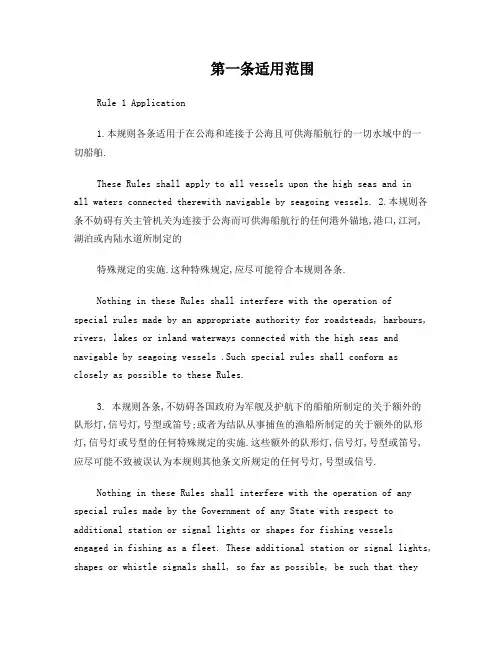
第一条适用范围Rule 1 Application1.本规则各条适用于在公海和连接于公海且可供海船航行的一切水域中的一切船舶.These Rules shall apply to all vessels upon the high seas and inall waters connected therewith navigable by seagoing vessels. 2.本规则各条不妨碍有关主管机关为连接于公海而可供海船航行的任何港外锚地,港口,江河,湖泊或内陆水道所制定的特殊规定的实施.这种特殊规定,应尽可能符合本规则各条.Nothing in these Rules shall interfere with the operation ofspecial rules made by an appropriate authority for roadsteads, harbours, rivers, lakes or inland waterways connected with the high seas and navigable by seagoing vessels .Such special rules shall conform asclosely as possible to these Rules.3. 本规则各条,不妨碍各国政府为军舰及护航下的船舶所制定的关于额外的队形灯,信号灯,号型或笛号;或者为结队从事捕鱼的渔船所制定的关于额外的队形灯,信号灯或号型的任何特殊规定的实施.这些额外的队形灯,信号灯,号型或笛号,应尽可能不致被误认为本规则其他条文所规定的任何号灯,号型或信号.Nothing in these Rules shall interfere with the operation of any special rules made by the Government of any State with respect to additional station or signal lights or shapes for fishing vessels engaged in fishing as a fleet. These additional station or signal lights, shapes or whistle signals shall, so far as possible, be such that theycannot be mistaken for any light, shape or signal authorized elsewhere under these Rules.4.为实施本规则,本组织可以采纳分道通航制.Traffic separation schemes may be adopted by the Organization for the purpose of these Rules.5.凡经有关政府确定,某种特殊构造或用途的船舶,如不能完全遵守本规则任何一条关于号灯或号型的数量,位置,能见距离或弧度以及声号设备的配置和特性的规定时,则应遵守其政府在号灯或号型的数量,位置,能见距离或弧度以及声号设备的配置和特性方面为之另行确定的尽可能符合本规则要求的规定.Whenever the Government concerned shall have determined that a vessel of special construction or purpose cannot comply fully with the provisions of any of these Rules with respect to the number, position, range or arc of visibility of lights or shapes, as well as to the disposition and characteristics of sound-signalling appliances, such vessel shall comply with such other provisions in regard to the number, position ,range or arc of the visibility of lights or shapes, as well as to the disposition and characteristics of sound-signalling appliances, as her Government shall have determined to be the closest possible compliance with these Rules in respect of that vessel.第二条责任Rule 2 Responsibility1.本规则各条并不免除任何船舶或其所有人,船长或船员由于对遵守本规则各条的任何疏忽,或者对海员通常做法或当时特殊情况可能要求的任何戒备上的疏忽而产生的各种后果的责任.Nothing in these Rules shall exonerate any vessel, or the owner, master or crew thereof, from the consequences of any neglect to comply with these Rules or of the neglect of any precaution which may be required by the ordinary practice of seamen, or by the special circumstances of the case.2.在解释和遵行本规则各条规定时,应适当考虑到,为避免紧迫危险而需背离本规则各条规定的一切航行和碰撞的危险,以及任何特殊情况,其中包括当事船舶条件限制在内.In construing and complying with these Rules due regard shall be had to all dangers of navigation and collision and to any special circumstances, including the limitations of the vessels involved, which may make a departure from these Rules necessary to avoid immediate danger.第三条一般定义Rule 3 General definitions除其他条文另有解释外,在本规则中:For the purpose of these Rules, except where the context otherwise requires:1.“船舶”一词,指用作或者能够用作水上运输工具的各类水上船筏,包括非排水船舶,水上飞机和地效翼船.The word “vessel”includes every description of water craft, including non-displacement craft ,WIG craft and seaplanes, used or capable of being used as a means of transportation on water.2.“机动船”一词,指用机器推进的任何船舶.The term“power-driven vessel ”means ay vessel propelled by machinery.3.“帆船”一词,指任何驶帆的船舶,包括装有推进机器而不在使用者.The term “sailing vessel”means any vessel under sail providedthat propelling machinery, if fitted, is not being used.4.“从事捕鱼的船舶”一词,指使用网具绳钓拖网或其他使其操纵性能受到限制的渔具捕鱼的任何船舶,但不包括使用曳绳钓或其他并不使其操纵性能受到限制的渔具捕鱼的船舶.The term “vessel engaged in fishing”means any vessel fishing with nets, lines, trawls or other fishing apparatus which restrict manoeuvrability , but does not include a vessel fishing with trolling lines or other fishing apparatus which do not restrict manoeuvrability.5.“水上飞机”一词,包括为能在水面操纵而设计的任何航空器.The word“seaplane”includes any aircraft designed to manoeuvre on the water.6.“失去控制的船舶”一词,指由于某种异常的情况不能按本规则各条的要求进行操纵,因而不能给他船让路的船舶.The term “vessel not under command”means a vessel which through some exceptional circumstance is unable to manoeuvre as required by these Rules and is therefore unable to keep out of the way of another vessel.7.“操纵能力受到限制的船舶”一词,指由于工作性质,使其按本规则要求进行操纵的能力受到限制,因而不能给他船让路的船舶. 操纵能力受到限制的船舶一词应包括,但不限于下列船舶:The t erm “vessel restricted in her ability to manoeuvre”means a vessel which from the nature of her work is restricted in her ability to manoeuvre as required by these Rules and is therefore unable to keep out of the way of another vessel. The term vessels restricted in theirability to manoeuvre shall include but not be limited to:(1)从事敷设,维修或起捞助航标志,海底电缆或管道的船舶;A vessel engaged in laying, servicing or picking up a navigation mark, submarine cable or pipeline.(2)从事疏浚,测量或水下作业的船舶;A vessel engaged in dredging, surveying or underwater operations.(3)在航中从事补给或转运人员,食品或货物的船舶;A vessel engaged in replenishment or transferring persons, provisions or cargo while underway.(4)从事发放或回收航空器的船舶;A vessel engaged in the launching or recovery of aircraft.(5)从事清除水雷作业的船舶;A vessel engaged in mine clearance operations.(6)从事拖带作业的船舶,而该项拖带作业使该拖船及其被拖船偏离所驶航向的能力严重受到限制.A vessel engaged in a towing operation such as severely restricts the towing vessel and her tow in their ability to deviate from their course.8.“限于吃水的船舶”一词,指由于吃水与可航水域的水深和宽度的关系,致使其偏离航向的能力严重的受到限制的机动船.The term “vessel constrained by her draught ”means a power-driven vessel which, because of her draught in relation to the available depth and width of navigable water, is severely restricted in her ability to deviate from the course she is following.9.“在航”一词,指船舶不在锚泊,系岸或搁浅.The word“underway”means that a vessel is not at anchor, or made fast to the shore, or aground.10.船舶的“长度和宽度”是指其总长度和最大宽度.The words “length and breadth” of a vessel mean her length overall an d greatest breadth.11.只有当一船能自他船以视觉看到时,才应认为两船是在互见中.Vessel shall be deemed to be in sight of one another only when one can be observed visually from the other.12“能见度不良”一词,指任何由于雾,霾,下雪,暴风雨,沙暴或任何其他类似原因而使能见度受到限制的情况.The term “restricted visibility” me ans any condition in which visibility is restricted by fog, mist, falling snow, heavy rainstorms, sandstorms or any other similar causes.13.“地效翼船”是一种模式的船艇,其主要操作模式是利用表面效应在相当接近水面的高度飞行.The term “Wing-In-Ground (WIG) craft” means a multimodal craft which, in its main operational mode flies in close proximity to the surface-effect action.第四条适用范围Rule 4 application本节各条适用于任何能见度的情况Rules in this section apply in any condition of visibility.第五条了望Rule 5 look-out每一船舶应经常用视觉,听觉以及适合当时环境和情况下一切有效的手段保持正规的了望,以便对局面和碰撞危险作出充分的估计.Every vessel shall at all times maintain a proper look-out by sight and hearing as well as by all available means appropriate in the prevailing circumstances and conditions so as to make a full appraisal of the situation and of the risk of collision.第六条安全航速Rule 6 safe speed每一船舶在任何时候均应用安全航速行驶,以便能采取适当而有效的避碰行动并能在适合当时环境和情况的距离以内把船停住.在决定安全航速时,考虑的因素中应包括下列各点:Every vessel shall at all times proceed at a safe speed so that she can take proper and effective action to avoid collision and be stopped within a distance appropriate to the prevailing circumstances and conditions. In determining a safe speed the following factors shall be among those taken into account:1.对所有船舶: By all vessels:(1)能见度情况; the state of visibility;(2)通航密度,包括渔船或者任何其他船舶的密集程度;The traffic density including concentrations of fishing vessels or any other vessels.(3)船舶的操纵性能,特别是在当时情况下的冲程和回转性能;The manoeuvrability of the vessel with special reference to stopping distance and turning ability in the prevailing conditions. (4)夜间出现的背景亮光,诸如来自岸上灯光或本船灯光的反向散射;At night the presence of background light such as from shore lights or from backscatter of her own lights.(5)风,浪和流的状况以及靠近航海危险物的情况;The state of wind, sea and current, and the proximity of navigational hazards(6)吃水与可用水深的关系.The draught in relation to the available depth of water.2.对备有可使用的雷达的船舶,还需考虑:Additionally, by vessels with operational radar:(1)雷达设备的特性,效率和局限性;The characteristics, efficiency and limitations of the radar equipment.(2)所选用的雷达距离标尺带来的任何限制;Any constraints imposed by the radar range scale in use.(3)海况,天气和其他干扰源对雷达探测的影响;The effect on radar detection of the sea state, weather and other sources of interference.(4)在适当距离内,雷达对小船,浮冰和其他漂浮物有探测不到的可能性;The possibility that small vessels, ice and other floating objects may not be detected by radar at an adequate range.(5)雷达探测到的船舶数目,位置和动态;The number, location and movement of vessels detected by radar.(6)当用雷达测定附近船舶或其他物体的距离时,可能对能见度作出的更确切的估计.The more exact assessment of the visibility that may be possible when radar is used to determine the range of vessels or other objects in the vicinity.第七条碰撞危险Rule 7 risk of collision1.每一船舶应用适合当时环境和情况的一切有效手段断定是否存在碰撞危险,如有任何怀疑,则应认为存在这种危险. Every vessel shall use all available means appropriate to the prevailing circumstances and conditions to determine if risk of collision exists, if there is any doubt such risk shall be deemed to exists.2.如装有雷达设备并可使用的话,则应正确予以使用,包括远距离扫描,以便获得碰撞危险的早期报警,并对探测到的物标进行雷达标绘或与其相当的系统观察.Proper use shall be made of radar equipment if fitted and operational, including long-range scanning to obtain early warning of risk of collision and radar plotting or equivalent systematic observation of detected objects.3.不应当根据不充分的资料,特别是不充分的雷达观测资料作出推断.Assumptions shall not be made on the basis of scanty information, especially scanty radar information4.在断定是否存在碰撞危险时,考虑的因素中应包括下列各点:In determining if risk of collision exists the following considerations shall be among those taken into account:(1)如果来船的罗经方位没有明显的变化,每则应认为存在这种危险;Such risk shall be deemed to exist if the compass bearing of an approaching vessel does not appreciably change.(2)即使有明显的方位变化,有时也可能存在这种危险,特别是在驶近一艘很大的船舶或拖带船组时,或是在近距离驶近他船时.Such risk may sometimes exist even when an appreciable bearing change is evident, particularly when approaching a very large vessel or a tow or when approaching a vessel at close range.第八条避免碰撞的行动Rule 8 action to avoid collision1.为避免碰撞所采取的任何行动,应按照本章的规定进行.如当时环境许可,应是积极的,并应及早的进行和注意运用良好的船艺.Any action to avoid collision shall be taken in accordance with the Rules of this Part and shall, if the circumstances of the case admit, be positive, made in ample time and with due regard to the observance of good seamanship.2.为避免碰撞而作的航向和(或)航速的任何变动,如当时环境许可,应大的足以使他船用视觉或雷达观察时容易察觉到;应避免对航向和(或)航速作一连串的小变动.Any alteration of course and/or speed to avoid collision shall, if the circumstances of the case admit, be large enough to be readily apparent to another vessel observing visually or by radar; a succession of small alteration of course and/or speed should be avoided.3.如有足够的水域,则单用转向可能是避免紧迫局面的最有效行动,倘若这种行动是及时的,大幅度的并且不致造成另一紧迫局面.If there is sufficient sea-room, alteration of course alone may be the most effective action to avoid a close-quarters situation provided that it is made in good time, is substantial and does not result in another close-quarter situation.4.为避免与他船碰撞而采取的行动,应能导致在安全的距离驶过.应细心查核避让行动的有效性,直到最后驶过让清他船为止.Action taken to avoid collision with another vessel shall be such as to result in passing at a safe distance. The effectiveness of the action shall be carefully checked until the other vessel is finally past and clear.5.如需避免碰撞或需留有更多的时间来估计局面,船舶应当减速或者停止或倒转推进器把船停住.If necessary to avoid collision or allow more time to assess the situation, a vessel shall slacken her speed or take all way off by stopping or reversing her means of propulsion.6.(1)根据本规则任何规定,要求不得妨碍另一艘船舶通过或安全通过的船舶应根据当时环境的需要及早的采取行动以留出足够的水域供其它船舶安全通过.A vessel which, by any of these Rules, is required not to impede the passage or safe passage of another vessel shall, when required by the circumstances of the case, take early action to allow sufficientsea-room for the safe passage of the other vessel.(2)如果在接近其它船舶致有碰撞危险时,被要求不得妨碍另一船舶通过的船舶并不解除这一责任,且当采取行动时,应充分考虑到本章各条可能要求的行动.A vessel required not to impede the passage or safe passage of another vessel is not relieved of this obligation if approaching the other vessel so asto involve risk of collision and shall, when taking action ,have full regard to the action which may be required by the Rules of this part.(3)当两船互相接近致有碰撞危险时,其通过不得被妨碍的船舶仍有完全遵守本章各条规定的责任.A vessel the passage of which is not to be impeded remains fully obliged to comply with the Rules of this part when thetwo vessels are approaching one another so as to involve risk of collision.第九条狭水道Rule 9 narrow channels1.船舶沿狭水道或航道行驶时,只要安全可行,应尽量靠近本船右舷的该水道或航道的外缘行驶.A vessel proceeding along the course of a narrow channel or fairway shall keep as near to the outer limit of the channel or fairway which lies on her starboard side as is safe and practicable.2.帆船或者长度小于20米的船舶,不应妨碍只能在狭水道或航道以内安全航行的船舶通行.A vessel of less than 20 m in length or a sailing vessel shall not impede the passage of a vessel which can safely navigate only within a narrow channel or fairway.3.从事捕鱼的船舶,不应妨碍任何其它在狭水道或航道以内航行的船舶通行.A vessel engaged in fishing shall not impede the passage of any other vessel navigating within a narrow channel or fairway.4.船舶不应穿越狭水道或航道,如过这种穿越会妨碍只能在这种水道或航道以内安全航行的船舶通行.后者若对穿越船的意图有怀疑时,可以使用第三十四条4款所规定的声号.A vessel shall not cross a narrow channel or fairway if such crossing impedes the passage of a vessel which can safely navigate only within such channel or fairway. The latter vessel may use the sound signal prescribed in Rule 34(d)if in doubt as to the intention of the crossing vessel.5.(1)在狭水道或航道内,如只有在被追越船必须采取行动以允许安全通过才能追越时,则企图追越的船,应鸣放第三十四条3款(1)项所规定的相应声号,以表示本船的意图,被追越船如果同意,应鸣放第三十四条3款(2)项所规定的相应声号,并采取使之能安全通过的措施.如有怀疑,则可以鸣放第三十四条4款所规定的声号.In a narrow channel or fairway when overtaking can take place only if the vessel to be overtaken has to take action to permit safe passing, the vessel intending to overtake shall indicate her intention by sounding the appropriate signal prescribed in Rule 34( c) (i), The vessel to be overtaken shall, if in agreement, sound the appropriate signal prescribed in Rule34( c)(ii) and take steps topermit safe passing. If in doubt she may sound the signals prescribed in Rule 34(d).(2)本条并不解除追越船根据第十三条所负的义务.This Rule does not relieve the overtaking vessel of her obligation under Rule 13.6.船在驶近可能被居间障碍物遮蔽他船的狭水道或航道的弯头或地段时,应特别机警和谨慎的驾驶,并应鸣放第三十四条5款所规定的相应声号.A vessel nearing a bend or an area of a narrow channel or fairway where other vessels may be obscured by an intervening obstruction shall navigate with particular alertness and caution and shall sound the appropriate signal prescribed in Rule34(e) 7.任何船舶,如当时环境许可,都应避免在狭水道内锚泊.Any vessel shall, if the circumstances of the case admit, avoid anchoring in a narrow channel.第十条分道通航制Rule 10 Traffic separation schemes1.本条适用于本组织采纳的分道通航制,但并不解除任何船舶遵守任何其他各条规定的责任。
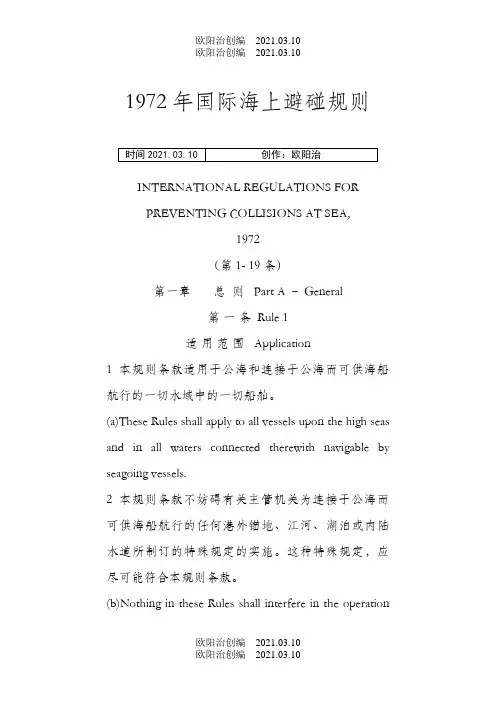
1972年国际海上避碰规则INTERNATIONAL REGULATIONS FORPREVENTING COLLISIONS AT SEA,1972(第1- 19条)第一章总则 Part A – General第一条 Rule 1适用范围 Application1 本规则条款适用于公海和连接于公海而可供海船航行的一切水域中的一切船舶。
(a)These Rules shall apply to all vessels upon the high seas and in all waters connected therewith navigable by seagoing vessels.2本规则条款不妨碍有关主管机关为连接于公海而可供海船航行的任何港外锚地、江河、湖泊或内陆水道所制订的特殊规定的实施。
这种特殊规定,应尽可能符合本规则条款。
(b)Nothing in these Rules shall interfere in the operationof special rules made by an appropriate authority for roadsteads, harbors, rivers, lakes or inland waterways connected with the high seas and navigable by seagoing vessels. Such special rules shall conform as closely as possible to these Rules.3.本规则条款不妨碍各国政府为军舰及护航下的船舶所制定的关于额外的队形灯、信号灯、号型或笛号,或者为结队从事捕鱼的渔船所制定的关于额外的队形灯、信号灯或号型的任何特殊规定的实施。
这些额外的队形灯、信号灯、号型或笛号,应尽可能不致被误认为本规则其他条文所规定的任何号灯、号型或信号。
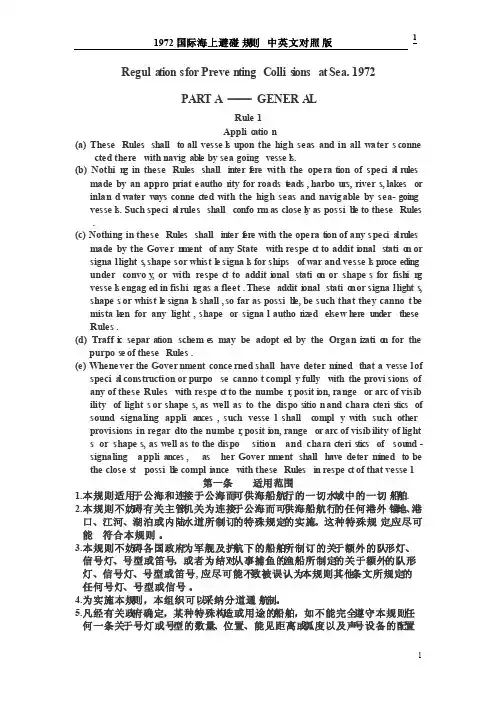
Regula tions for Preven ting Collis ions at Sea. 1972PART A ──GENERA LRule 1Applic ation(a) These Rules shall to all vessel s upon the high seas and in all waters connected therewith navigable by sea goingvessel s.(b) Nothin g in theseRules shall interf er e with the operation of specia l r ulesmade by an appropriate author ity for roadst eads, harbour s, rivers, lakesor inland waterw ays connec ted with the high seas and naviga ble by sea- goingvessel s. Such specia l rules shall confor m as closel y as possib l e to theseRules .(c) Nothin g in theseRules shall interf er e with the operat ion of any specia l r ulesmade by the Govern m ent of any Statewith respec t to additi onal statio n or signal lights, shapes or whistl e signal s for shipsof war and vessel s pr oceedingunderconvoy, or with respec t to additi onal statio n or shapes for fishin g vessel s engaged in fishin g as a fleet. Theseadditi onal statio n or signal lights, shapes or whistl e signal s shall, so far as possib l e, be such that they cannot be mistak en for any light,shapeor signal author iz edelsewh er e undertheseRules.(d) Traffi c separa tion scheme s may be adopte d by the Organiz atio n for thepurpos e of theseRules.(e) Whenev er the Govern mentconcer ned shallhave determ inedthat a vessel ofspecia l constr uctio n or purpos e cannot comply fullyw ith the provis ionsof any of theseRulesw ith respec t to the number, positi on, rangeor arc of visibilityof lights or shapes, as well as to the disposition and character is tics of sound-s ignal ing applia nces,such vessel shallc omply with such otherprovis ionsin regard to the number, positi on, rangeor arc of visibi lityof lights or shapes, as well as to the dispos ition and charac teris ticsof sound-signal ing applia nces,as her Governm ent shall have determ inedto be the closest possib l e compli ancew ith theseRulesin respec t of that vessel.第一条适用范围1.本规则适用于公海和连接于公海而可供海船航行的一切水域中的一切船舶.2.本规则不妨碍有关主管机关为连接于公海而可供海船航行的任何港外锚地、港口、江河、湖泊或内陆水道所制订的特殊规定的实施。
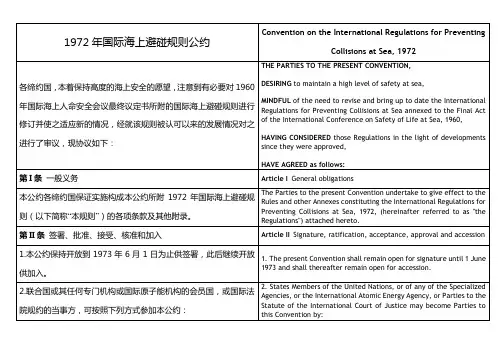
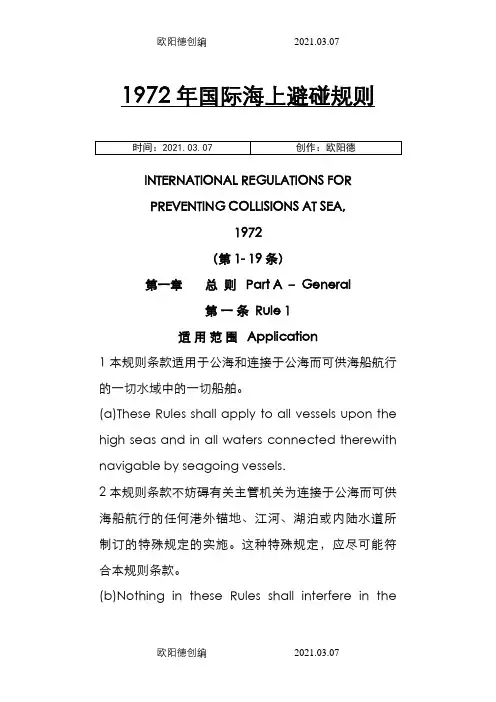
1972年国际海上避碰规则INTERNATIONAL REGULATIONS FORPREVENTING COLLISIONS AT SEA,1972(第1- 19条)第一章总则 Part A – General第一条 Rule 1适用范围 Application1 本规则条款适用于公海和连接于公海而可供海船航行的一切水域中的一切船舶。
(a)These Rules shall apply to all vessels upon the high seas and in all waters connected therewith navigable by seagoing vessels.2本规则条款不妨碍有关主管机关为连接于公海而可供海船航行的任何港外锚地、江河、湖泊或内陆水道所制订的特殊规定的实施。
这种特殊规定,应尽可能符合本规则条款。
(b)Nothing in these Rules shall interfere in theoperation of special rules made by an appropriate authority for roadsteads, harbors, rivers, lakes or inland waterways connected with the high seas and navigable by seagoing vessels. Such special rules shall conform as closely as possible to these Rules.3.本规则条款不妨碍各国政府为军舰及护航下的船舶所制定的关于额外的队形灯、信号灯、号型或笛号,或者为结队从事捕鱼的渔船所制定的关于额外的队形灯、信号灯或号型的任何特殊规定的实施。
这些额外的队形灯、信号灯、号型或笛号,应尽可能不致被误认为本规则其他条文所规定的任何号灯、号型或信号。
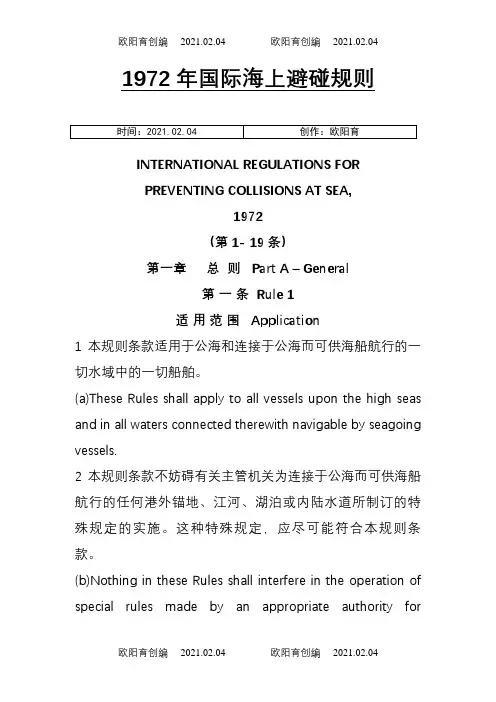
1972年国际海上避碰规则INTERNATIONAL REGULATIONS FORPREVENTING COLLISIONS AT SEA,1972(第1- 19条)第一章总则 Part A – General第一条 Rule 1适用范围 Application1 本规则条款适用于公海和连接于公海而可供海船航行的一切水域中的一切船舶。
(a)These Rules shall apply to all vessels upon the high seas and in all waters connected therewith navigable by seagoing vessels.2本规则条款不妨碍有关主管机关为连接于公海而可供海船航行的任何港外锚地、江河、湖泊或内陆水道所制订的特殊规定的实施。
这种特殊规定,应尽可能符合本规则条款。
(b)Nothing in these Rules shall interfere in the operation of special rules made by an appropriate authority forroadsteads, harbors, rivers, lakes or inland waterways connected with the high seas and navigable by seagoing vessels. Such special rules shall conform as closely as possible to these Rules.3.本规则条款不妨碍各国政府为军舰及护航下的船舶所制定的关于额外的队形灯、信号灯、号型或笛号,或者为结队从事捕鱼的渔船所制定的关于额外的队形灯、信号灯或号型的任何特殊规定的实施。
这些额外的队形灯、信号灯、号型或笛号,应尽可能不致被误认为本规则其他条文所规定的任何号灯、号型或信号。
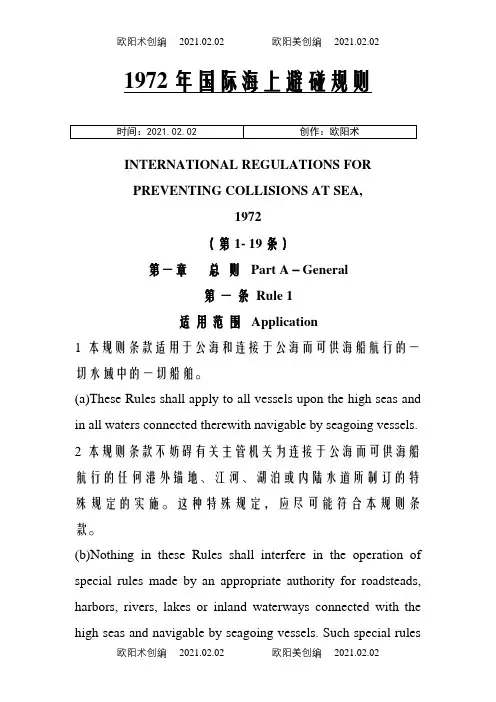
1972年国际海上避碰规则INTERNATIONAL REGULATIONS FORPREVENTING COLLISIONS AT SEA,1972(第1- 19条)第一章总则 Part A – General第一条 Rule 1适用范围 Application1 本规则条款适用于公海和连接于公海而可供海船航行的一切水域中的一切船舶。
(a)These Rules shall apply to all vessels upon the high seas and in all waters connected therewith navigable by seagoing vessels. 2本规则条款不妨碍有关主管机关为连接于公海而可供海船航行的任何港外锚地、江河、湖泊或内陆水道所制订的特殊规定的实施。
这种特殊规定,应尽可能符合本规则条款。
(b)Nothing in these Rules shall interfere in the operation of special rules made by an appropriate authority for roadsteads, harbors, rivers, lakes or inland waterways connected with the high seas and navigable by seagoing vessels. Such special rulesshall conform as closely as possible to these Rules.3.本规则条款不妨碍各国政府为军舰及护航下的船舶所制定的关于额外的队形灯、信号灯、号型或笛号,或者为结队从事捕鱼的渔船所制定的关于额外的队形灯、信号灯或号型的任何特殊规定的实施。
这些额外的队形灯、信号灯、号型或笛号,应尽可能不致被误认为本规则其他条文所规定的任何号灯、号型或信号。
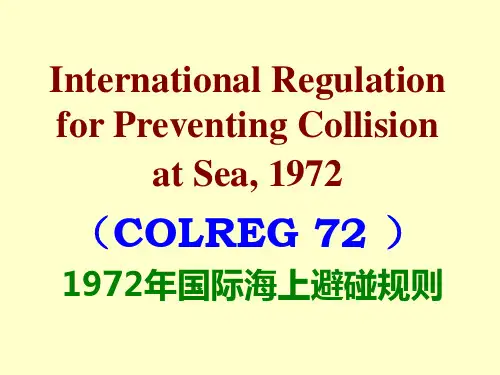
1972年国际海上避碰规则INTERNATIONAL REGULATIONS FORPREVENTING COLLISIONS AT SEA,1972(第1- 19条)第一章总则 Part A – General第一条 Rule 1适用范围 Application1 本规则条款适用于公海和连接于公海而可供海船航行的一切水域中的一切船舶。
(a)These Rules shall apply to all vessels upon the high seas and in all waters connected therewith navigable by seagoing vessels. 2本规则条款不妨碍有关主管机关为连接于公海而可供海船航行的任何港外锚地、江河、湖泊或内陆水道所制订的特殊规定的实施。
这种特殊规定,应尽可能符合本规则条款。
(b)Nothing in these Rules shall interfere in the operation of special rules made by an appropriate authority for roadsteads, harbors, rivers, lakes or inland waterways connected with the high seas and navigable by seagoing vessels. Such special rulesshall conform as closely as possible to these Rules.3.本规则条款不妨碍各国政府为军舰及护航下的船舶所制定的关于额外的队形灯、信号灯、号型或笛号,或者为结队从事捕鱼的渔船所制定的关于额外的队形灯、信号灯或号型的任何特殊规定的实施。
这些额外的队形灯、信号灯、号型或笛号,应尽可能不致被误认为本规则其他条文所规定的任何号灯、号型或信号。
1972年国际海上避碰规则(中英)[借鉴]
1972年国际海上避碰规则(COLREGS)是由国际海事组织(IMO)制定和颁布的一套规则,此规则是为了确保所有船只在公海上安全航行的基础。
根据该规则的要求,所有船只必须采取必要的预防措施来避免碰撞。
下面是COLREGS的主要规定:
第一章:一般规定
此章节规定规则的适用范围、定义、基本原则和责任等内容。
第二章:船只在海上遇到的一般情况
此章节规定在海上遇到的一般情况下船只应该如何采取预防措施,主要包括:遇到危险信号、正在作业的船只、渔船和小船、年轻和不稳定船只等。
第三章:根据可能发生的情况和状况采取的行动规则
此章节规定在不同的情况下船只应该采取的行动规则,主要包括:遇到其他船舶、有多艘船舶交会的情况、船只遇到雷暴等。
第四章:信号规则
此章节规定船只在不同情况下应该发出的信号,如遇到突发情况时紧急呼叫、发出航行通告等。
此章节规定了在特定情况下需要遵循的控制信号规则,如遇到特别危险的情况时发出控制信号来指示其他船只行动。
第六章:曳航和推船的规则
此章节规定在曳航和推船时双方应该遵循的规则,如避免与其他船只相撞等。
第七章:船只灯光规则
此章节规定船只在夜间应该点亮的灯光种类、位置和颜色等,以便其他船只能及时认出这艘船只的状态。
第八章:雾中航行规则
此章节规定在雾中航行时船只应该采取的行动规则,如降低航速、听取雷达信号等。
1972年国际海上避碰规则INTERNATIONAL REGULATIONS FORPREVENTING COLLISIONS AT SEA,1972(第1- 19条)第一章总则 Part A – General第一条 Rule 1适用范围 Application1 本规则条款适用于公海和连接于公海而可供海船航行的一切水域中的一切船舶。
(a)These Rules shall apply to all vessels upon the high seas and in all waters connected therewith navigable by seagoing vessels.2本规则条款不妨碍有关主管机关为连接于公海而可供海船航行的任何港外锚地、江河、湖泊或内陆水道所制订的特殊规定的实施。
这种特殊规定,应尽可能符合本规则条款。
(b)Nothing in these Rules shall interfere in the operation of special rules made by an appropriate authority forroadsteads, harbors, rivers, lakes or inland waterways connected with the high seas and navigable by seagoing vessels. Such special rules shall conform as closely as possible to these Rules.3.本规则条款不妨碍各国政府为军舰及护航下的船舶所制定的关于额外的队形灯、信号灯、号型或笛号,或者为结队从事捕鱼的渔船所制定的关于额外的队形灯、信号灯或号型的任何特殊规定的实施。
这些额外的队形灯、信号灯、号型或笛号,应尽可能不致被误认为本规则其他条文所规定的任何号灯、号型或信号。
Regulations for Preventing Collisions at Sea. 1972之迟辟智美创作PART A ── GENERALRule 1Application(a) These Rules shall to all vessels upon the high seasand in all watersconnected therewith navigable by seagoingvessels.(b) Nothing in these Rules shall interfere with theoperation of specialrules made by an appropriate authorityfor roadsteads, harbours, rivers, lakes or inland waterwaysconnected with the high seas and navigable by sea- goingvessels. Such special rules shall conform as closely aspossible to these Rules.(c) Nothing in these Rules shall interfere with theoperation of anyspecial rules made by the Government ofany State with respect to additional station or signallights, shapes or whistle signals for ships of war andvessels proceeding under convoy, or with respect to additional station or shapes for fishing vessels engaged infishing as a fleet. These additional station or signallights, shapes or whistlesignals shall, so far as possible, be such that they cannot be mistaken for any light, shapeor signal authorized elsewhere under these Rules.(d) Traffic separation schemes may be adopted by theOrganization forthe purpose of these Rules.(e) Whenever the Government concerned shall have determined that avessel of special construction or purpose cannot comply fully with the provisions of any of these Rules with respect to the number, position,range or arc ofvisibility of lights or shapes, as well as tothedisposition and characteristics of sound-signaling appliances, such vessel shall comply with such other provisions in regard to the number, position, range or arc of visibility of lights or shapes, as well as to the disposition andcharacteristics of sound- signaling appliances, as herGovernment shall have determined to be the closest possiblecompliance with these Rules in respect of that vessel.第一条适用范围1.本规则适用于公海和连接于公海而可供海船航行的一切水域中的一切船舶.2.本规则无妨碍有关主管机关为连接于公海而可供海船航行的任何港外锚地、港口、江河、湖泊或内陆水道所制订的特殊规定的实施.这种特殊规定,应尽可能符合本规则.3.本规则无妨碍各国政府为军舰及护航下的船舶所制订的关于额外的队形灯、信号灯、号型或笛号,或者为结对从事打鱼的渔船所制定的关于额外的队形灯、信号灯、号型或笛号, 应尽可能不致被误认为本规则其他条文所规定的任何号灯、号型或信号.4.为实施本规则,本组织可以采纳分道通航制.5.凡经有关政府确定,某种特殊构造或用途的船舶,如不能完全遵守本规则任何一条关于号灯或号型的数量、位置、能见距离或弧度以及声号设备的配置和特性的规按时,则应遵守其政府在号灯或号型的数量、位置、能见距离或弧度以及声号设备的配置和特性方面为之另行确定的尽可能符合本规则要求的规定.Rule 2Responsibility(a) Nothing in these Rules shall exonerate any vessel,or the owner,master or crew thereof, from the consequencesof any neglect to comply with these Rules or of the neglectof any precaution which may be required by the ordinarypractice of seamen, or by the special circumstances of the case.(b) In construing and complying with these Rules dueregard shall behad to all dangers of navigation and collisionand to any special circumstances, including the limitationsof the vessels involved, which may make a departure fromthese Rules necessary to avoid immediate danger.第二条责任1.本规则其实难免除任何船舶或其所有人、船主或船员由于遵守本规则的任何疏忽,或者海员通常做法要求的或那时特殊情况要求的任何戒备上的疏忽而发生的各种后果的责任.2.在解释和遵守本规则时,应考虑到一切航行和碰撞的危险以及包括当事船舶条件限制在内的任何特殊情况,这些危险和特殊情况可能使船舶在需要时为防止紧迫危险而叛变本规则.Rule 3General DefinitionsFor the purpose of these Rules, except where the contextotherwise requires:(a) The word "vessel"includes every description ofwater craft,including non- displacement craft and seaplanes,used or capable of being used as a means of transportation on water.(b) The term "power- driven vessel" means any vesselunder sail provided that propelling machinery, if fitted, isnot being used.(d) The term"vessel engaged in fishing" means any vesselfishing with nets, lines, trawls or other fishing apparatuswhich restrict maneuverability, but does not include avessel fishing with trolling lines or other fishing apparatus which do not restrict maneuverability.(e) The word "seaplane" includes any aircraft designed to manoeuvre on the water.(f) The term "vessel not under command" means a vesselwhich through some exceptional circumstance is unable tomanoeuvre as required by these Rules and is thereforeunable to keep out of the way of another vessel.(g) The term "vessel restricted in her ability tomanoeuvre" means a vessel which from the nature of her workis restricted in her ability to manoeuvre as required by these Rules and is therefore unable to keep out of the way of another vessel. The term "vessels restricted in theirability to manoeuvre" shall include but not be limited to:(i) A vessel engaged in laying, servicing or picking up a navigation mark, submarine cable or pipeline;(ii) A vessel engaged in dredging, surveying or underwater operations; (iii) A vessel engaged in replenishment or transferring persons, provisions or cargo while underway;(iv) a vessel engaged in the launching or recovery of aircraft;(v) a vessel engaged in mine clearance operations;(vi) a vessel engaged in a towing operation such as severely restricts the towing vessel and her tow in their abilityto deviate from their course.(h) The term "vessel constrained by her draught" meansa power-driven vessel which, because of her draught inrelation to the available depth and width of navigable water, is severely restricted in her ability to deviate from the course she is following.(i) The word "underway" means that a vessel is not atanchor, or made fast to the shore, or aground.(j) The words "length" and "breadth" of a vessel meanher length overall and greatest breadth.(k) Vessels shall be deemed to be in sight of one another only when one can be observed visually from the other.(L) The term "restricted visibility" means any conditionin which visibility is restricted by fog, mist, fallingsnow, heavy rainstorms, sandstorms or any other similarcauses.第三条一般界说除其他条文另有解释外,在本规则中:1.“船舶”一词,指用作或者能够用作水上运输工具的各类水上船筏,包括非排水船舶和水上飞机.2.“机动船”一词,指用机器推进的任何船舶.3.“帆船”一词,指任何驶帆的船舶,包括装有推进机器而不在使用者.4.“从事打鱼的船舶”一词,指使用网具、绳钓、拖网或其他使其操纵性能受到限制的渔具打鱼的任何船舶,但不包括使用曳绳钓或其他其实不使其操纵性能受到限制的渔具打鱼的船舶.5.“水上飞机”一词,包括为能在水面操纵而设计的任何航空器. 6.“失去控制的船舶”一词,指由于某种异常的情况,不能按本规则各条的要求进行操纵,因而不能给他船让路的船舶.7.“操纵能力受到限制的船舶”一词,指由于工作性质,使其按本规则要求进行操纵的能力受到限制,因而不能给他船让路的船舶. “操纵能力受到限制的船舶”一词应包括,但不限于下列船舶:(1)从事敷设、维修或起捞助航标识表记标帜、海底电缆或管道的船舶;(2)从事疏浚、丈量或水下作业的船舶;(3)在航中从事补给或转运人员、食品或货物的船舶;(4)从事发放或回收航空器的船舶;(5)从事清除水雷作业的船舶;(6)从事拖带作业的船舶,而该项拖带作业使该拖船及其被拖船偏离所驶航向的能力严重受到限制者.8.“限于吃水的船舶”一词,指由于吃水与可用水深的关系,致使其偏离所驶航向的能力严重地受到限制的机动船.9.“在航”一词,指船舳不在锚泊、系岸或搁浅.10.船舶的“长度”和“宽度”是指其总长度和最年夜宽度.11.只有当一船能自他船以视觉看到时,才应认为两船是在互见中.12.“能见度不良”一词,指任何由于雾、霾、下雪、狂风雨、沙暴或任何其他类似原因而使能见度受到限制的情况.PART B-STEERING AND SAILING RULESSECTION 1-CONDUCT OF VESSELS IN ANYCONDITION OF VISIBILITYRule 4ApplicationRules in this Section apply in any condition of visibility第二章驾驶和航行规则第一节船舶在任何能见度情况下的行动规则(第四——第十条)Rule 5Look-outEvery vessel shall at all times maintain a proper lookout by sight and hearing as well as by all available meansappropriate in the prevailingcircumstances and conditionsso to make a full appraisal of thesituation and of the risk of collision.第五条了望每一船应在任何时候用视觉、听觉以及适合那时环境和情况的一切可用手段坚持正规的了望,以便对局面和碰撞危险作出充沛的估计.Rule 6Safe speedEvery vessel shall at all times proceed at a safe speedso that she can take proper and effective action to avoidcollision and be stopped within a distanceappropriate tothe prevailing circumstances and conditions.In determining a safe speed the following factors shallbe among those taken into account:(a) By all vessels:(i) The state of visibility;(ii) The traffic density including concentrations of fishing vessels or any other vessels;(iii)The manoeuvrability of the vessel with specialreference to stopping distance and turning ability in theprevailing conditions;(iv) at night the presence of background light such as from shore lights or from back scatter of her own lights;(v) the state of wind, sea and current, and the proximityof navigational hazards;(vi) the draught in relation to the available depth of water.(b) Additionally, by vessels with operational radar;(i) the characteristics, efficiency and limitations of the radar equipment;(ii) any constraints imposed by the radar range scale in use;(iii) the effect on radar detection of the sea state,weather and other sources of interference;(iv) the possibility that small vessels, ice and other floating objects may not be detected by radar at an adequate range;(v) The number, location and movement of vesselsdetected by radar; (vi) The more exact assessment of the visibility thatmay be possible when radar is used to determine the range of vessels or other objects in the vicinity.第六条平安航速每一船在任何时候都应用平安航速行驶,以便能采用适当而有效的行动防止碰撞,并能在适合那时环境和情况的距离以内把船停住.在决定平安航速时,考虑的因素中应包括下列各点:1.对所有船舶:(1)能见度情况;(2)通航密度,包括渔船或者任何其他船舶的密集水平;(3)船舶的操纵性能,特别是在那时情况下的冲程和旋回性能;(4)夜间呈现的布景亮光,诸如来自岸上的灯光或本船灯光的反向散射;(5)风、浪和流的状况以及靠近航海危险物的情况:(6)吃水与可用水深的关系.2.对备有可使用的雷达的船舶,还须考虑:(1)雷达设备的特性、效率和局限性;(2)所选用的雷达距离标尺带来的任何限制;(3)海况、天气和其他干扰源对雷达探测的影响;(4)在适当距离内,雷达对小船、浮冰和其他漂浮物有探测不到的可能性;(5)雷达探测到的船舶数目、位置和静态;(6)当用雷达测定附近船舶或其他物体的距离时,可能对能见度作出的更确切的估计.Rule 7Risk of Collision(a) Every vessel shall use all available means appropriate to theprevailing circumstances and conditions to determine if risk of collision exists. If there is any doubt suchrisk shall be deemed to exist.(b) Proper use shall be made of radar equipment if fitted andoperational, including long-range scanning to obtainearly warning of risk of collision and radar plotting orequivalent systematic observation of detected objects.(c) Assumptions shall not be made on the basis of scantyinformation,especially scanty radar information.(d) In determining ifrisk of collision exists thefollowing considerationsshall be among those taken into account:(i) Such risk shall be deemed to exist if the compassbearing of an approaching vessel does not appreciably change:(ii) Such risk may sometimes exist even when an appreciable bearing change is evident, particularly when approachinga very large vessel or a tow or when approaching a vessel atclose range.第七条碰撞危险1.每一船应用适合那时环境和情况的一切可用手段判定是否存在碰撞危险,如有任何怀疑,则应认为存在这种危险.2.如装有雷达设备并可使用的话,则应正确予以使用,包括远距离扫瞄,以便获得碰撞危险的早期警报,并对探测到的物标进行雷达标绘或与其相当的系统观察.3.不应当根据不充沛的资料,特别是不充沛的雷达观测资料作出推断.4.在判定是否存在碰撞危险时,考虑的因素中应包括下列各点:(1)如果来船的罗经方位没有明显的变动,则应认为存在这种危险;(2)即使有明显的方位变动,有时也可能存在这种危险,特别是在驶近一艘很年夜的船或拖带船组时,或是在近距离驶近他船时.Rule 8Action to avoid Collision(a) Any action to avoid collision shall, if the circumstances of the caseadmit, be positive, made in ample timeand with due regard to the observance of good seamanship.(b) Any alteration of course and / or speed to avoidcollision shall, if thecircumstances of the case admit, be large enough to be readily apparent to another vessel observing visually or by radar; a succession of small alterations of course and / or speed should be avoided.(c) If there is sufficient sea room, alteration ofcourse alone may be themost effective action to avoid aclose-quarters situation provided that it is made in goodtime, is substantial and does not result in another closequarters situation.(d) Action taken to avoid collision with another vesselshall be such as toresult in passing at safe distance, the effectiveness of the action shall be carefully checkeduntil the other vessel is finally past and clear. (e) If necessary to avoid collision or allow more timeto assess thesituation, a vessel shall slacken her speedor take all way off by stopping or reversing her means ofpropulsion.(f) (i) A vessel which, by any of these rules, is required not to impede thepassage or safe passage of anothervessel shall, when required by the circumstances of the case, take early action to allow sufficient sea- room for thesafe passage of the other vessel.(ii) A vessel required not to impede the passage orsafe passage of another vessel is not relieved of thisobligation if approaching the other vessel so as to involverisk of collision and shall, when taking action, have full regard to the action which may be required by the rules of this part.(iii) A vessel the passage of which is not to be impededremains fully obliged to comply with the rules of this part when the two vessels are approaching one another so as to involve risk of collision.第八条防止碰撞的行动1.为防止碰撞所采用的任何行动,如那时环境许可,应是积极的,应及早地进行并注意运用良好的船艺.2.为防止碰撞而作的航向和(或)航速的任何变动,如那时环境许可,应年夜得足以使他船用视觉或雷达观察时容易发觉到;应防止对航向和(或)航速作一连串的小变动.3.如有足够的水域,则单用转向可能是防止紧迫局面的最有效行动,只要这种行动是及时的,年夜幅度的而且不至造成另一紧迫局面.4.为防止与他船碰撞而采用的行动,应能招致在平安的距离驶过.应细心查核遁藏行动的有效性,直到最后驶过让清他船为止.5.为防止碰撞或留有更多时间来估计局面,需要时, 船舶应当减速或者停止或倒转推进器把船停住.6. (1)根据本规则任何规定,要求不得妨碍另一艘船通过或平安通过的船舶应根据那时环境的需要及早地采用行动以留出足够的水域供他船平安通过.(2)如果在接近其他船舶致有碰撞危险时,被要求不得妨碍另一艘船通过或平安通过的船舶其实不解除这一责任,且当采用行动时,应充沛考虑到本章各条可能要求的行动.Rule 9Narrow Channels(a) A vessel proceeding along the course of a narrowchannel or fairwayshall keep as near to the outer limit ofthe channel orfairway which lies on her starboard side asis safe and practicable.(b) A vessel of less than 20 meters in length or asailing vessel shall notimpede the passage of a vesselwhich can safely navigate only within narrow channel orfairway.(c) A vessel engaged in fishing shall not impede thepassage of any othervessel navigating within a narrowchannel or fairway.(d) A vessel shall not cross a narrow channel or fairwayif such crossingimpedes the passage of a vessel which cansafely navigate only within such channel or fairway. Thelatter vessel may use the sound signal prescribed in Rule 34(d) if in doubt as to the intention of the crossing vessel.(e) (i) In a narrow channel or fairway when overtaking can take placeonly if the vessel to be overtaken has to take action to permit safe passing, the vessel intending to overtake shall indicate her intention by sounding the appropriate signal prescribed in Rule 34(c)(i). The vesselto be overtaken shall,if in agreement, sound the appropriatesignal prescribed in Rule 34(c)(ii) and take steps to permitsafe passing. If in doubt she may sound the signalsprescribed in Rule 34(d).(ii) This Rule does not relieve the overtaking vessel ofher obligation under Rule 13.(f) A vessel nearing a bend or an area of a narrow channel or fairway where other vessels may be obscured by an intervening obstruction shall navigate with particularalertness and caution and shall soundthe appropriate signalprescribed in Rule 34(e).(g) Any vessel shall, if the circumstances of the caseadmit, avoid anchoring in a narrow channel.第九条狭水道1.船舶沿狭水道或航道行驶时,只要平安可行,应尽量靠近其右舷的该水道或航道的外缘.2.帆船或者长度小于20米的船舶,不应妨碍只能在狭水道或航道以内平安航行的船舶通行.3.从事打鱼的船舶,不应妨碍任何其他在狭水道或航道以内航行的船舶通行.4.船舶不应穿越狭水道或航道,如果这种穿越会妨碍只能在这种水道或航道以内平安航行的船舶通行.后者若对穿越船的意图有怀疑时,可以使用第三十四条4款所规定的声号.5.(1)在狭水道或航道内,如只有在被追越船必需采用行动以允许平安通过能追越时,则企图追越的船,应鸣放第三十四条3款(1)项所规定的相应声号,以暗示本船的意图.被追越船如果同意,应鸣放第三十四条3款(2) 所规定的相应声号,并采用使之能平安通过的办法.如有怀疑,则可以鸣放第三十四条4款所规定的声号.(2)本条其实不解除追越船根据第十三条所负的义务.6.船舶在驶近其他船舶可能被居间障碍物遮蔽的狭水道或航道的弯头或地段时,应特别机警和谨慎地驾驶,并应鸣放第三十四条5款所规定的相应声号.7.任何船舶,如那时环境许可,都应防止在狭水道内锚泊.Rule 10Traffic Separation Schemes(a) This rule applies to traffic separation schemes adopted by the Organization and does not relieve any vessel of her obligation under any other rule.(b) A vessel using a traffic separation scheme shall:(i) proceed in the appropriate traffic lane in the general direction of traffic flow for that lane;(ii) so far as practicable keep clear of a traffic separation line or separation zone;(iii) normally join or leave a traffic lane at thetermination of the lane, but when joining or leaving fromeither side shall do so at as small an angle to the generaldirection of traffic flow as practicable. (c) A vessel shall, so far as practicable, avoidcrossing traffic lanes but if obliged to do so shall crosson a heading as nearly as practicable at right angles tothe general direction of traffic flow.(d) (i) A vessel shall not use an inshore traffic zonewhen she can safely use the appropriate traffic lane withinthe adjacent traffic separation scheme. However, vessels ofless than 20 metres in length, sailing vessels and vesselsengaged in fishing may use the inshore traffic zone. (ii) Notwithstanding subparagraph (d)(i), a vessel mayuse an inshore traffic zone when en route to or from a port,offshore installation or structure, pilot station or anyother place situated within the inshore traffic zone, or toavoid immediate danger.(e)A vessel other than a crossing vessel or a vessel joining or leaving a lane shall not normally enter a separation zone or cross a separation line except:(i)in case of emergency to avoid immediate danger:(ii)to engage in fishing within a separation zone.(f) A vessel navigating in areas near the terminationsof traffic separation schemes shall do so with particularcaution.(g) A vessel shall so far as practicable avoid anchoringin a traffic separation scheme or in areas near itsterminations.(h) A vessel not using a traffic separation schemeshall avoid it by as wide a margin as is practicable.(i) A vessel engaged in fishing shall not impede thepassage of any vessel following a traffic lane.(j) A vessel of less than 20 metres in length or asailing vessel shall not impede the safe passage of a power-driven vessel following a traffic lane.(k) A vessel restricted in her ability to manoeuvre whenengaged in an operation for the maintenance of safety ofnavigation in a traffic separation scheme is exempted fromcomplying with this Rule to the extent necessary to carryout the operation.(l) A vessel restricted in her ability to manoeuvre whenengaged in an operation for the laying, servicing or pickingup of a submarine cable, within a traffic separation scheme,is exempted from complying with this Rule to the extentnecessary to carry out the operation.第十条分道通航制1.本条适用于本组织所采纳的各分道通航制, 但其实不解除任何船舶遵守任何其他各条规定的责任.2.使用分道通航制区域的船舶:(1)在相应的通航分道内顺着该分道的船舶总流向行驶;(2)尽可能让开分隔线或分隔带;(3)通常在通航分道的端部驶进或驶出,但从分道的任何一侧驶进或驶出时, 应与分道的船舶总流向形成尽可能小的角度;3.船舶应尽可能防止穿越通航分道,但如不能不穿越时,应尽可能用与分道的船舶总流向成直角的船首向穿越;4.(1)当船舶可平安使用邻近分道通航制区中相应通航分道时,不应使用沿岸通航带.但长度小于20米的船舶、帆船和从事打鱼的船舶可使用沿岸通航带;(2)除本条4(1)规定外,当船舶抵离港口、近岸设施或建筑物、引航站或位于沿岸通航带中的任何处所或为防止紧迫危险时,可使用沿岸通航带;5.除穿越船或者驶进或驶出通航分道的船舶外, 船通常不应进入分隔带或穿越分隔线,除非:(1)在紧急情况下防止紧迫危险;(2)在分隔带内从事打鱼;6.船舶在分道通航制区域端部附近行驶时,应特别谨慎;7.船舶应尽可能防止在分道通航制区域内或其端部附近锚泊;8.不使用分道通航制区域的船舶,应尽可能远离该区域.9.从事打鱼的船舶,不应妨碍按通航分道行驶的任何船舶的通行;10.帆船或长度小于20米的船舶,不应妨碍按通航分道行驶的机动船的平安通行;11.操纵能力受到限制的船舶,当在分道通航制区域内从事维护航行平安的作业时,在执行该作业所必需的限度内,免受本条规定的约束;12.操纵能力受到限制的船舶,当在分道通航制区域内从事敷设、维护或起捞海底电缆时,在执行该作业所必需的限度内,免受本条规定的约束.SECTION Ⅱ-CONDUCT OF VESSELS INSIGHT OF ONE ANOTHERRule 11ApplicationRules in this section apply to vessels in sight of oneanother.第二节船舶在互见中的行动规则(第十一条——第十八条)第十一条适用范围本节各条适用于互见中的船舶.Rule 12Sailing Vessels(a) When two sailing vessels are approaching one another,so as toinvolve risk of collision, one of them shall keepout of the way of the other as follows:(i) when each has the wind on a different side, the vessel which has thewind on the port side shall keep out ofthe way of the other.(ii) when both have the wind on the same side, thevessel which is to wind-ward shall keep out of the way ofthe vessel which is to leeward; (iii) if a vessel with the wind on the port side sees avessel to windward and cannot determine with certaintywhether the other vessel has the wind on the port or on the starboard side, she shall keep out of the way of the other.(b) For the purpose of this Rule the windward sideshall be deemed to be the side opposite to that on which themainsail is carried or, in the case of a square- riggedvessel, the side opposite to that on which the largest foreandaft sail is carried.第十二条帆船1.两艘帆船相互驶近致有构成碰撞危险时,其中一船应按下列规定给他船让路:(1)两船在分歧舷受风时,左舷受风的船应给他船让路;(2)两船在同舷受风时,上风船应给下风船让路;(3)如左舷受风的船看到在上风的船而不能判定究竟该船是左舷受风还是右舷受风,则应给该船让路.2.就本条规定而言,船舶的受风舷侧应认为是主帆被吹向的一舷的对面舷侧;对方帆船,则应认为是最年夜纵帆被吹向的一舷的对面舷侧.Rule 13Overtaking(a) Notwithstanding anything contained in the Rules ofPart B, Sections I and II, any vessel overtaking any othershall keep out of the way of the vessel being overtaken.(b) A vessel shall be deemed to be overtaking whencoming up with another vessel from a direction more than 22.5 degrees abaft her beam, that is, in such a position withreference to the vessel she is overtaking, that at night shewould be able to see only the sternlight of that vessel butneither of her sidelights.(c) When a vessel is in any doubt as to shethat she isovertaking another, she shall assume that this is the caseand act accordingly.(d) Any subsequent alternation of the bearing betweenthe two vessels shall not make the overtaking vessel a crossing vessel within the meaning of these Rules or relieve herof the duty of keeping clear of the overtaken vessel untilshe is finally past and clear.第十三条追越1.不论第二章第一节和第二节的各条规定如何,任何船舶在追越任何他船时,均应给被追越船让路.2.一船正从他船正横后年夜于22.5度的某一方向赶上他船时, 即该船对其所追越的船所处的位置,在夜间只能看见被追越船的尾灯而不能看见他的任一舷灯时,应认为是在追越中.3.当一船对其是否在追越他船有任何怀疑时,该船应假定是在追越,并应采用相应行动.中所指的交叉船,或者免除其让开被追越船的责任,直到最后驶过让清为止.Rule 14Head-on Situation(a) When two power-driven vessels are meeting on reciprocal or nearly reciprocal courses so as to involve risk ofcollision each shall alter her course to starboard so thateach shall pass on the port side of the other.(b) Such a situation shall be deemed to exist when avessel sees the other ahead or nearly ahead and by nightshe could see the masthead lights of the other in a line ornearly ina line and/or both sidelights and by day sheobserves the corresponding aspect of the other vessel.(c) When a vessel is in any doubt as to whether such asituation exists she shall assume that it does exist andact accordingly.第十四条对遇局面1.当两艘机动船在相反的或接近相反的航向上相遇有构成碰撞危险时, 各应向右转向,从而各从他船的左舷驶过.2.当一船看见他船在正前方或接近正前方,而且在夜间,能看见他船的前后桅灯成一直线或接近一直线和(或)两盏灯;在白天看到他船的上述相应形态时,则应认为存在这样的局面.3.当一船对是否存在这样的局面有任何怀疑时,该船应假定确实存在这种局面,并应采用相应的行动.Rule 15Crossing SituationWhen two power-driven vessels are crossing so as to involve risk of collision, the vessel which has the other onher own starboard side shall keep out of the way and shall,if the circumstances of the case admit, avoid crossing aheadof the other vessel.第十五条交叉相遇局面当两艘机动船交叉相遇致有构成碰撞危险时, 有他船在本船右舷的船舶应给他船让路,如那时环境许可,还防止横越他船的前方.Rule 16Action by Give-way VesselEvery vessel which is directed to keep out of the wayof another vessel shall, so far as possible, take early andsubstantial action to keep well clear.第十六条让路船的行动须给他船让路的船舶,应尽可能及早地采用年夜幅度的行动,宽裕地让清他船.Rule 17Action by Stand-on Vessel(a) (i) Where one of two vessels is to keep out of theway the other shall keep her course and speed.(ii) The latter vessel may however take action to avoidcollision by her manoeuvre alone, as soon as it becomes apparent to her that the vessel required to keep out of theway is not taking appropriate action in compliance withthese Rules.(b) When, from any cause, the vessel required to keepher course and speed finds herself so close that collisioncannot be avoided by the action of the give- way vesselalone, she shall take such action as will best aid to avoidcollision.(c) A power-driven vessel which takes action in a crossing situation in accordance with sub-paragraph (a)(ii) ofthis Rule to avoid collision with another power- drivenvessel shall, if the circumstances of the case admit, notalter course to port for a vessel on her own port side.(d) This Rule does not relieve the give- way vessel ofher obligation to keep out of the way.第十七条直航船的行动1. (1)两船中的一船应给另一船让路时,另一船应坚持航向和航速.(2)然而,当坚持航向和航速的船一经发觉规定的让路船显然没有遵照本规则采用适当行动时,该船即可单独采用操纵行动,以防止碰撞.2.当规定坚持航向和航速的船, 发觉本船不论由于何种原因迫近到单凭让路船的行动不能防止碰撞时,也应采用最有助于避碰的行动.3.在交叉相遇的局面下,机动船依照本条1款(2) 项采用行动以防止与另一艘机动船碰撞时,如那时环境许可,不应对在本船左舷的船采用向左转向.4.本条其实不解除让路船的让路义务.Rule 18Responsibilities between VesselsExcept where Rules 9, 10 and 13 otherwise require:(a) A power-driven vessel underway shall keep out ofthe way of:(i) A vessel not under command:(ii)A vessel restricted in her ability to manoeuvre;(iii) A vessel engaged in fishing;(iv) Asailingvessel.(b) A sailing vessel underway shall keep out of the wayof:(i) A vessel not under command:(ii) A vessel restricted in her ability to manoeuvre;(iii) A vessel engaged in fishing;(c) A vessel engaged in fishing when underway shall, sofar as possible, keep out of the way of:(i) A vessel not under command:(ii) A vessel restricted in her ability to manoeuvre.(d) (i) Any vessel other than a vessel not under commandor a vessel restricted in her ability to manoeuvre shall, ifthe circumstances of the case admit, avoid impeding the safepassage of a vessel constrained by her draught, exhibitingthe signals in Rule 28.(ii) A vessel constrained by her draught shall navigatewith particular caution having full regard to her specialcondition.(e) A seaplane on the water shall, in general, keep wellclear of all vesselsand avoid impeding their navigation.In circumstances, however, where risk of collision exists,she shall comply with the Rules of this Part.第十八条船舶之间的责任除第九、十和十三条另有规定外:1.机动船在航时应给下述船舶让路:(1)失去控制的船舶;(2)操纵能力受到限制的船舶;(3)从事打鱼的船舶;(4)帆船;2.帆船在航时应给可下述船舶让路:(1)失去控制的船舶;(2)操纵能力受到限制的船舶;(3)从事打鱼的船舶3.从事打鱼的船舶在航时,应尽可能给下述船舶让路:(1)失去控制的船舶;(2)操纵能力受到限制的船舶;4.(1)除失去控制的船舶或操纵能力受到限制的船舶外,任何船舶如那时环境许可,应防止妨碍显示第二十八条信号的限于吃水的船舶的平安通行.(2)限于吃水的船舶应充沛注意到其特殊条件,特别谨慎地驾驶.5.在水面的水上飞机,通常应宽域地让清所有的船舶并防止妨碍其航行.然而在有碰撞危险的情况下,则应遵守本章各条的规定.SECTION III-CONDUCT OF VESSELS INRESTRICTED VISIBILITY第三节船舶在能见度不良时的行动规则。
1972 年国际海上避碰规则INTERNATIONAL REGULATIONS FORPREVENTING COLLISIONS AT SEA,1972(第1- 19条)第一章总则Part A –General第一条Rule 1适用范围Application1 本规则条款适用于公海和连接于公海而可供海船航行的一切水域中的一切船舶。
(a)These Rules shall apply to all vessels upon the high seas and in all waters connected therewith navigable by seagoing vessels.2本规则条款不妨碍有关主管机关为连接于公海而可供海船航行的任何港外锚地、江河、湖泊或内陆水道所制订的特殊规定的实施。
这种特殊规定,应尽可能符合本规则条款。
(b)Nothing in these Rules shall interfere in the operation of special rules made by an appropriate authority for roadsteads, harbors, rivers, lakes or inland waterways connected with the high seas and navigable by seagoing vessels. Such special rules shall conform as closely as possible to these Rules.3.本规则条款不妨碍各国政府为军舰及护航下的船舶所制定的关于额外的队形灯、信号灯、号型或笛号,或者为结队从事捕鱼的渔船所制定的关于额外的队形灯、信号灯或号型的任何特殊规定的实施。
这些额外的队形灯、信号灯、号型或笛号,应尽可能不致被误认为本规则其他条文所规定的任何号灯、号型或信号。
(c) Nothing in these Rules shall interfere with the operation of any special rules made by the Government of any State with respect to additional station or signal lights or shapes or whistle signals for ships of war and vessels proceeding under convoy, or with respect to additional station or signal lights for fishing vessels fishing as a fleet. These additional station or signal lights or whistle signals shall, so far as possible, be such that they cannot be mistaken for any light, shape, or signal authorized elsewhere under these Rules.4.为实施本规则,本组织可以采纳分道通航制。
(d) Traffic separation schemes may be adopted by the Organization for the purpose of these Rules.5凡经有关政府确定,某种特殊构造或用途的船舶,如不能完全遵守本规则任何一条关于号灯或号型的数量、位置、能见距离或弧度以及声号设备的配置和特性的规定时,则应遵守其政府在号灯或号型的数量、位置、能见距离或弧度以及声号设备的配置和特性方面为之另行确定的尽可能符合本规则条款要求的规定。
(e) Whenever the Government concerned shall have determined that a vessel of special construction or purpose cannot comply fully with the provisions of any of these Rules with respect to number, position, range or arc of visibility of lights or shapes, as well as to the disposition and characteristics of sound-signalling appliances, such vessel shall comply with such other provisions in regard to number, position, range or arc of visibility of lights or shapes, as well as to the disposition and characteristics of sound-signalling appliances, as her Government shall have determined to be the closest possible compliance with these Rules in respect to that vessel.第二条Rule 2责任Responsibility1.本规则条款并不免除任何船舶或其所有人、船长或船员由于遵守本规则条款的任何疏忽,或者按海员通常做法或当时特殊情况所要求的任何戒备上的疏忽而产生的各种后果的责任。
(a) Nothing in these Rules shall exonerate any vessel, or the owner, master, or crew thereof, from the consequences of any neglect to comply with these Rules or of the neglect of any precaution which may be required by the ordinary practice of seamen, or by the special circumstances of the case.2.在解释和遵行本规则条款时,应充分考虑一切航行和碰撞的危险以及包括当事船舶条件限制在内的任何特殊情况,这些危险和特殊情况可能需要背离本规则条款以避免紧迫危险。
(b) In construing and complying with these Rules due regard shall be had to all dangers of navigation and collision and to any special circumstances, including the limitations of the vessels involved, which may make a departure from these Rules necessary to avoid immediate danger.第三条Rule 3一般定义General Definitions除条文另有解释外,在本规则中:For the purpose of these Rules, except where the context otherwise requires:1“船舶”一词,指用作或者能够用作水上运输工具的各类水上船筏,包括非排水船筏和水上飞机。
(a) The word "vessel" includes every description of watercraft, including non-displacement craft and seaplanes, used or capable of being used as a means of transportation on water.2“机动船”一词,指用机器推进的任何船舶。
(b) The term "power driven vessel" means any vessel propelled by machinery.3.“帆船”一词,指任何驶帆的船舶,如果装有推进器但不在使用。
(c) The term "sailing vessel" means any vessel under sail provided that propelling machinery, if fitted, is notbeing used.4、“从事捕鱼的船舶”一词,指使用网具、绳钓、拖网或其他使其操纵性能受到限制的渔具捕鱼的任何船舶,但不包括使用曳绳钓或其他并不使其操纵性能受到限制的渔具捕鱼的船舶。
(d) The term "vessel engaged in fishing" means any vessel fishing with nets, lines, trawls, or other fishing apparatus which restrict maneuverability, but does not include a vessel fishing with trolling lines or other fishing apparatus which do not restrict manageability.5“水上飞机”一词,包括为能在水面操纵而设计的任何航空器。
(e) The term "seaplane" includes any aircraft designed to maneuver on the water.6“失去控制的船舶”一词,指由于某种异常情况,不能按本规则条款的要求进行操纵,因而不能给他船让路的船舶。
(f) The term "vessel not under command" means a vessel which through some exceptional circumstance is unable to maneuver as required by these Rules and is therefore unable to keep out of the way of another vessel.7“操纵能力受到限制的船舶”一词,指由于工作性质,使其按本规则条款的要求进行操纵的能力受到限制,因而不能给他船让路的船舶。